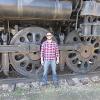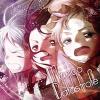Search the Community
Showing results for tags 'Boxcab'.
Found 4 results
-
After some conversation in another thread I realized I haven't posted any of my more recent builds on here, including one of my boxcab electric locomotives. I figured I would put some details about both of my New Haven electric locomotives, since both fit this category. Many of you may have seen these on Flickr or at shows but I presume that many of you haven't seen them yet, though I could be wrong. First up is the newest one, my New York, New Haven & Hartford Railroad (NYNH&H) EF-1: The EF-1 class was built in 1912 by Baldwin-Westinghouse and remained in service until 1957 (outlasting their "successors," the EF-2's by 9 years). The were frequently used on the New York Connecting Railroad (a joint venture to connect the New Haven and Pennsylvania Railroads) hauling freight from New England to the Long Island Rail Road's transfer bridges in Brooklyn, NY. Due to the grades on this route they were typically operated in triple, and I've even seen a photo of four of them hauling a long freight over the Hell Gate Bridge. The model is equipped with two PF train motors which power the four large drivers, and Brickstuff lights in the main headlight and four front marker lights. Contrary to everything I've read on here, I've had no problems using large drivers on a PF train motor (well, none yet). My plan is to build freight cars until this can no longer haul any more, then build a second and repeat until I have three of them. My second (well, first) boxcab electric is my NYNH&H EP-3: The EP-3 class was built by General Electric in 1931, and featured both pantographs and third rail shoes so they could run into either Grand Central Terminal or Pennsylvania Station in New York. The EP-3s performed so well that the Pennsylvania railroad borrowed three of them for tests that resulted in the design of the world famous GG1. As with my EF-1 this uses two PF train motors powering eight of the large drivers, and was able to keep considerable speed at Brickworld this past summer with five heavy passenger cars in tow: New Haven Meet at Brickworld Chicago Also I'm working on a NYNH&H EP-2, which is still very much of a WIP: Cheers!
- 18 replies
-
- Boxcab
- Locomotive
-
(and 2 more)
Tagged with:
-
After the last boxcab, Commander Wolf and I figured we had to go smaller. And slower. So we decided that both of us should build a motorized model of a GE 23-ton boxcab. We agreed to build them models independently, then meet up and compare approaches. We started with the same scaling image: Since there was some variation among the prototypes, choice of details was a matter of taste. I took most of my references from here. Here's my finished model: The original locomotive is really tiny, so I tried to keep the model about 7 studs wide. There's a lot of SNOT in this model: The main chassis is upside-down, the deckplate and frames are held against that using Technic pins, and the body attaches to some jumpers on the deckplate: The battery box is mounted sideways in the body and the power switch is reached by jabbing an antenna through the window. The roof is actually only held on by gravity: Originally I wasn't sure if I was going to put the caution-stripe tiles on the frames, but codefox421 vouched for them. You can see the full Brickshelf gallery here. So, what did Commander Wolf do? Read on...
- 17 replies
-
- Boxcab
- micromotor
-
(and 6 more)
Tagged with:
-
Somewhere between talking to CommanderWolf about boxcabs, seeing his HH1000, and reading up on old diesel-electric locomotives on the internet, I somehow got the idea to build a model of the very first production diesel-electric locomotives in the United States. These locomotives were produced by a consortium of three companies: ALCo, General Electric, and Ingersoll-Rand. Diminutive as they were (this model represents a 60-ton, 300hp locomotive), they are the direct ancestors of the diesel-electric locomotives powering the US rail system today. As far as I can tell, only three locomotives were actually built with this specific layout: CNJ #1000, B&O #1, and Lehigh Valley 100. Later models featured doors at both ends in addition to the sides; in addition, larger 100-ton versions were built. They could run in either direction, although there are distinct ends and sides: the above image shows the "B" side and "2" end (which I consider the "rear" of the locomotive). I went into construction pretty set on equipping this locomotive with Power Functions while still building an accurate model (at the same scale as the rest of my locomotives). While there are examples of very small Power-Functions-equipped locomotives, I was pretty much dead-set against using the Power Functions train motor -- the locomotive would be too fast, and I wouldn't be able to accurately model the trucks. So, I had to fit motor(s), battery box, and receiver into the shell of the locomotive: As usual, the Power Functions receiver turned out to be the biggest bugbear in this whole adventure. Its shape is extremely inconvenient. While there is just barely enough room to fit Power Functions M motors vertically inside the locomotive above the trucks, placing them would imply that the battery box would have to go between them ... leaving no room for the receiver. I was not going to accept powering only one of the trucks (for a model this light, you need all the traction you can get). The locomotive is not long enough to orient the M motors any other way, so I turned to the trusty 9V gearmotor instead. However, I determined that, even using that motor, there wasn't enough room inside the model for both two motors and the receiver. It was around this point that I decided that 7-wide was the correct width for the model, to avoid it looking too big (it also resulted in better proportions for the windows at the end of the locomotive). At 7-wide, there are only 5 studs of width inside the locomotive, of which 4 studs are taken up by the battery box. The transmission would have to either be 1 stud wide, or I would have to integrate panels into the side of the locomotive in the hopes of hiding the gearing. So what did I do? Restrictions breed creativity: (chain doesn't connect correctly due to LDD difficulties) Turns out, the entire drivetrain can be made to fit into the space available using a chain. The grey idler wheel attaches to a 1x2 brick with pin in the wall of the locomotive. Other parts of the drivetrain are similarly integrated with the body, and the motor and battery box form integral parts of the model's frame. The Power Functions receiver just barely fits in this awkward position above the gears on the non-motor end, and receives signals through a trans-black 1x2 brick on the roof: It is actually a pretty decent puller despite its small size (it is the "AGEIR" listed in this thread; the power rating has since risen to ~0.2W after I carefully lubricated and reassembled the entire drive system). Oddly for a PF-equipped locomotive, it is possible to back-drive the motor by pushing the locomotive, due to the low mechanical resistance of the 9V gearmotor. An additional side "benefit" of the drive system is that the chain makes a pleasant diesel-like clicking/rumbling sound when the locomotive is in motion. As troublesome as all these restrictions (that I placed on myself...) were, I really enjoyed figuring out how to fit all the mechanical components into such a small space, while still maintaining an accurate depiction of the prototype. It just goes to show what's possible using Power Functions. Brickshelf gallery here. If you're curious about the history of these locomotives, you can read about them here.
- 14 replies
-
- power functions
- diesel-electric
-
(and 3 more)
Tagged with:
-
Boxcab Shunter Hi guys, I've just finished a new Power Functions boxcab locomotive. I hope you guys like it. It was my first ever Power Functions MOC and I think it came out quite well. Here are the specs length: 16 bricks (with couplings) hight: 11 plates colour: yellow motor: PF train motor battery box: AAA weight: 314,1 gram But without further ado, Here are some pictures of it! Front view side view Motor How I hid the battery box And how I hid the reciever the only problem is that it doesn't have any wagons... And I have zero idea about what to build for it. I thought about some giant boat trailer or a flatbed but I scrapped those ideas. Bye



